China pushes for bamboo to replace plastics
By: Li Shangyi contributed to this story.

China pushes for bamboo to replace plastics
Zhejiang county at forefront of drive to switch to greener, lower-carbon goods
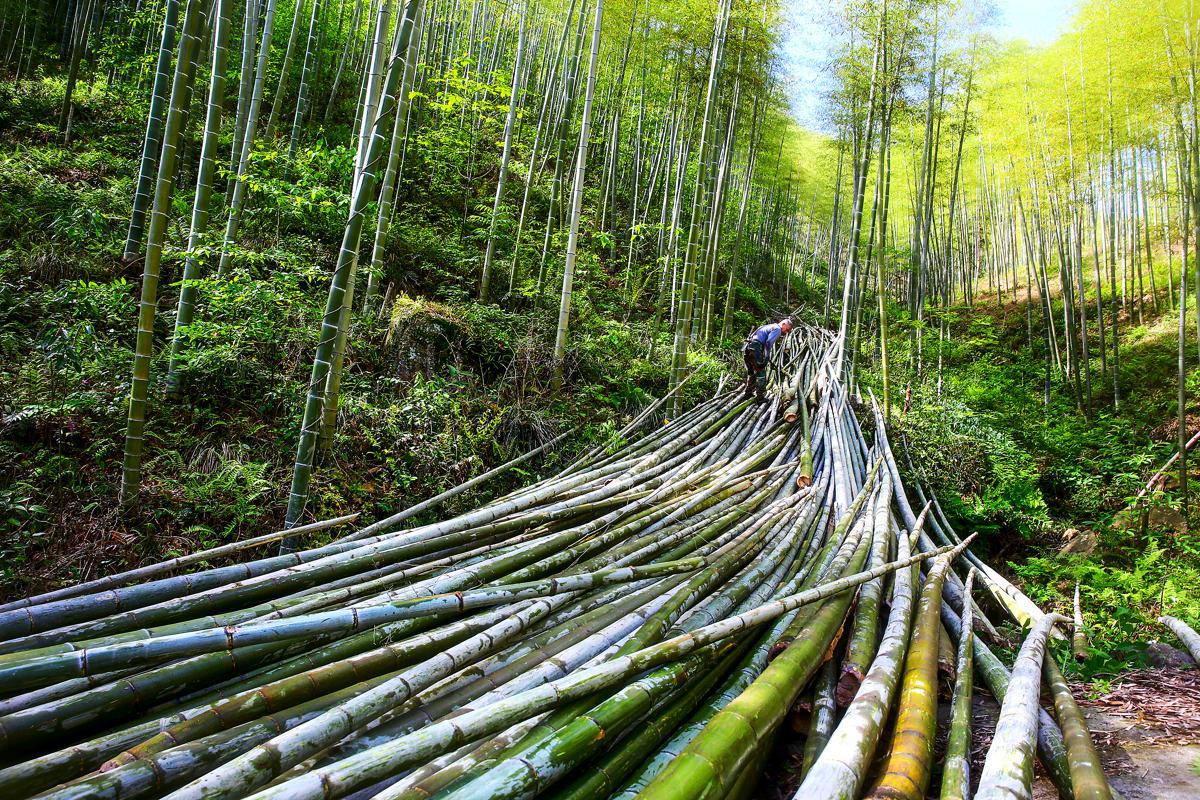
A forestry worker fells bamboo trees in Anji, Zhejiang province, in April. CHINA DAILY
The versatility of bamboo has long been known in China, where the giant woody grass has been utilized since the 11th century BC, taking the form of any number of useful items from food, transport and weapons to housing, paper and instruments.
China has 7.01 million hectares of bamboo forests and is the world's largest producer and exporter of bamboo products, according to the National Forestry and Grassland Administration.
The nation's bamboo forests account for an area similar in size to the entirety of Ireland.
It's estimated that the world produces around 400 million metric tons of plastic waste each year, and bamboo has arisen as a viable and environmentally friendly replacement due to its versatility and higher level of biodegradability.
At the forefront of the movement to replace plastics with bamboo are major bamboo production areas in China such as Zhejiang, Fujian, Sichuan, Guangdong and Anhui provinces.
In Anji, a county in northwestern Zhejiang province, bamboo is already replacing plastic in various products, from single-use takeaway cutlery to toothbrushes and combs used in hotels and homestays.
With 666 square kilometers of bamboo forests, an area about 80 percent of the size of New York City, and a long-standing history of bamboo use, Anji is serving as a model in advancing bamboo as an alternative to plastic.
In 2023, China launched a three-year plan to accelerate the industrial development of bamboo as a substitute for plastic with Anji designated as one of the first demonstration bases.
Bai Xia, who manages Anji's bamboo products exhibition center that showcases the innovative uses of the plant, said, "Since 2022, bamboo food trays have been replacing plastic ones in local government canteens and affiliated bodies."
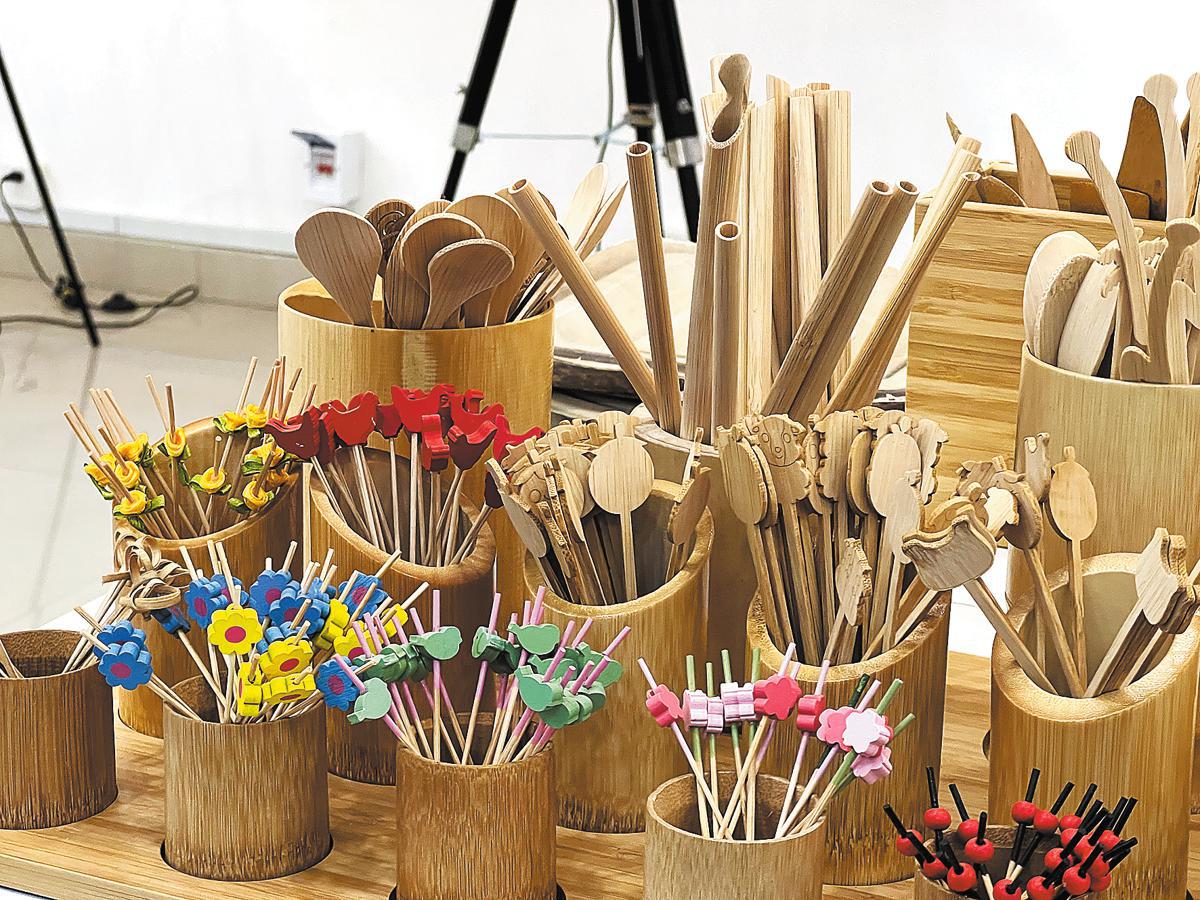
Cutlery made from bamboo are displayed at a demonstration center in Anji. LI SHANGYI/CHINA DAILY
Bamboo's potential as a plastic substitute takes on various forms in the exhibition center — from bamboo cutlery, straws and packaging boxes to bedding and clothing made from bamboo fiber.
Bai said that bamboo cutlery, toothbrushes, combs and toothpaste are widely used in Anji, and that bamboo-made tableware features in more than 300 restaurants and hotels in the county.
"In local markets, plastic bags have also been replaced by biodegradable bags made from 60 percent bamboo powder," she said. "These bamboo-based bags can break down within three months and yet they are tougher than plastic bags."
On the farm, bamboo-based film is replacing plastic film used for heat and water preservation. "As bamboo film is biodegradable, farmers no longer need to collect film waste in the field," Bai added.
Kindergartens in Anji have also adopted bamboo-made toys for children to play with, including toy bricks and models.
The estimated annual yield of bamboo is between 400,000 tons and 500,000 in Anji, according to Tang Hui from the local forestry department.
Bamboo undergoes several processes on its journey to becoming a versatile material.
Some products such as construction materials, cups and straws are made directly from bamboo through physical processing, while others, like pressed trays, bamboofiber clothing and packaging materials made of bamboo pulp, are created through chemical processing, Tang said.
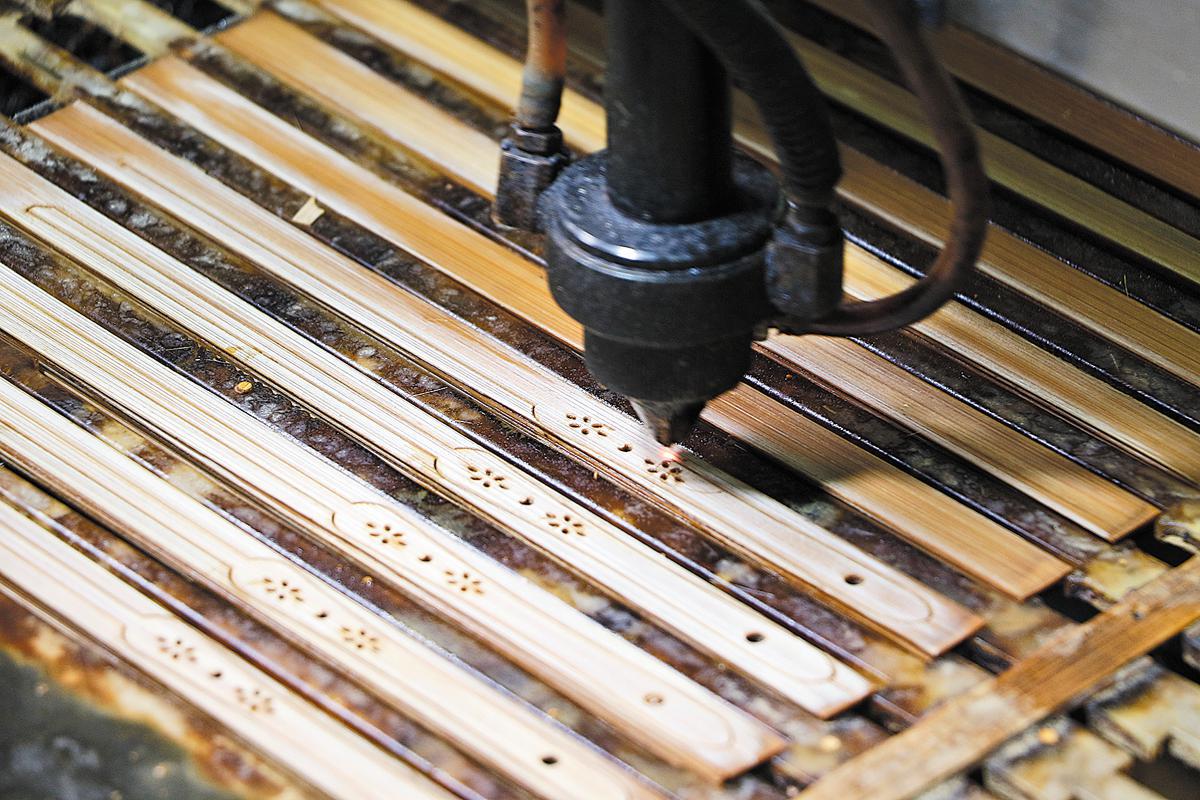
A machine carves out patterns on a bamboo fan in Anji in March 2023. SHI ZINAN/CHINA NEWS SERVICE
As an Anji local, Bai is well-acquainted with the long-standing role of bamboo in daily life. "When I was young, bamboo-woven baskets and chairs were quite common," she recalled. "However, bamboo-based materials used to be prone to mildew in humid environments."
Thanks to improved processing techniques, bamboo products have become more durable and resistant to these limitations, said Bai.
For example, through high-temperature carbonization, bamboo is transformed into charcoal, which is then used to produce mold-resistant bamboo charcoal chairs and chopsticks. Fallen bamboo shoot shells, once discarded in the forest, are now pressed into food trays or plates for use in food delivery and camping.
Tang said, "The initiative of using bamboo to substitute plastic was proposed in 2022, but the shift from wood, metal and plastics to bamboo has been a long journey in Anji."
Bamboo's advantages lie not only in its resilience and strength but also in its fast growth and renewable capacity. Compared to wood, which can take over a decade to grow, bamboo matures in just four to six years, enabling multiple harvests without the need for replanting.
"Adequate cutting is beneficial to the bamboo ecosystem," Tang said. "If bamboo isn't harvested, it becomes vulnerable to diseases and pests. Moreover, if it blossoms it is unable to regrow. Overgrown bamboo can fall, and dry bamboo can pose a fire risk to the forests."
In Anji, the industrial development of bamboo benefits local communities as well. Villagers earn income from harvesting bamboo, and bamboo's strong carbon sequestration capacity provides additional revenue through carbon credit exchanges, according to Tang.
Bamboo has become a cornerstone of Anji's economy, with around 1,000 enterprises engaged in the industry.
The county has been implementing the philosophy of "Lucid waters and lush mountains are invaluable assets", which was proposed by President Xi Jinping in Anji 20 years ago when he was then secretary of the Communist Party of China Zhejiang Provincial Committee.

A worker checks the quality of a bamboo fan in Anji in March 2023. SHI ZINAN/CHINA NEWS SERVICE
In 2023, Anji's bamboo industry generated approximately 18 billion yuan ($2.46 billion) in revenue.
Liang Fenghui, general manager of Zhejiang Fenghui Bamboo and Wood Co, based in Anji, said the company earned 130 million yuan in revenue in 2023 by selling bamboo-based products both domestically and internationally, including to Europe, Japan, the United States and Southeast Asia. Exports account for about 80 percent of the company's total revenue, he said.
Founded in the 1990s by Liang's father, the company focuses on manufacturing environmentally friendly bamboo products. "We specialize in consumables, packaging and lamps, with the majority of our materials sourced from bamboo," Liang said.
Bamboo consumables, including single-use knives, forks and toothbrushes, are designed for replacement within three months, aligning with efforts to reduce plastic usage. Some items, like bamboo sticks, are now produced automatically by machines.
At the company's factory, workers assemble bamboo lamps, which will be exported to European markets. "We have replaced plastic components in our lamps with bamboo as well," Liang added. The company is also enhancing value by incorporating cultural elements into the design of its packaging.
While the outlook for bamboo as a substitute alternative is promising, Liang acknowledged that domestic demand may take time to grow as consumer attitudes shift.
Bamboo products are already gaining traction in European and other international markets, but the domestic market still requires incentives to drive industry growth, according to Tang.
"Replacing wood materials with bamboo is already a common practice," he said. "However, using bamboo to fully substitute plastic is not an easy task. So far, there are only limited scenarios in which bamboo is used as a substitute for plastic in daily life."
One major challenge is the price difference between bamboo and plastic. Although plastic production based on fossil fuels generates more greenhouse gases, it remains cheaper due to lower labor and transportation costs compared to bamboo harvesting and processing, according to Tang.
"The price difference makes consumers favor plastic products," he said. "While we highlight bamboo's potential to reduce plastic pollution, the public often struggles to connect with it, as it seems distant from their everyday lives."
On the online shop for Anji's bamboo products, a bamboo toothbrush costs 3 yuan, and a bamboo Bluetooth keyboard is priced at 299 yuan. "The prices of these bamboo products are becoming more competitive compared to plastic alternatives," Bai said.
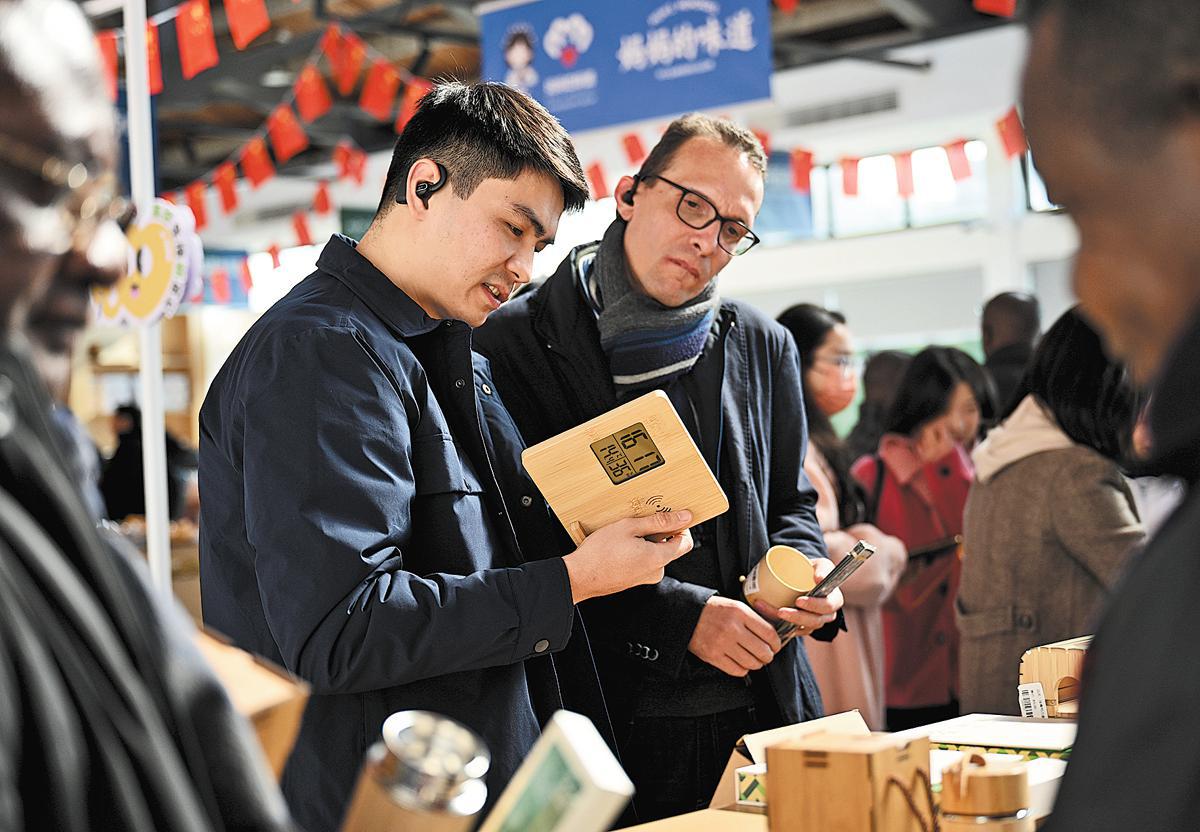
Visitors learn about bamboo products at a demonstration center in Anji in December.
The government has introduced subsidies for certain bamboo products to reduce their prices and promote wider adoption. "These subsidies help bamboo products compete with plastic items, especially since many consumers are still unfamiliar with bamboo alternatives," she said.
"Consumer awareness is key," said Tang. "To further promote bamboo products in daily life, we need to shift traditional consumption habits."
In efforts to lower costs, Anji has developed low-altitude ropeways and drones to transport bamboo from the mountains.
"As automation boosts productivity and brings costs down, the increasing supply of bamboo should be met with rising demand so as to achieve market equilibrium," Tang said.
Anji is exploring bamboo's potential to replace not just wood and plastics but also steel, gas and even food. According to Tang, bamboo can serve as a renewable energy source based on its high caloric value, as a construction material because of its hardness, as a healthy food option and as a biomass material in cosmetics.
"To fully realize bamboo's ecological and social benefits, cross-sector collaboration is essential," he said.
Tang highlighted that using bamboo to replace plastic goes beyond just production. The entire life cycle of bamboo replacing plastics involves production, consumption and disposal.
Li Shangyi contributed to this story.
Editor's note: China Daily is publishing a series illustrating the country's efforts to achieve its carbon peak and carbon neutrality goals.
The administrator of this group reserves the right, along with the site moderators, to moderate all and any postings to this group, including the right to enforce the ToS, the CoC, and also including anything that the administrator deems within his sole discretion to be offensive, including but not limited to political and/or off topic comments, with the power to delete in exercising that right.
It would be best, therefore, to be civil in posting on this group and not contravene the CoC, the ToS, and to not post comments that are political, insulting, taunting, trolling or offensive.
By now it should be well known that I am unable to open certain sources, videos and pictures. If I cannot, I will ask that they be described and explained. If the poster refuses to comply, their comment will be deleted. Instagrams are banned.

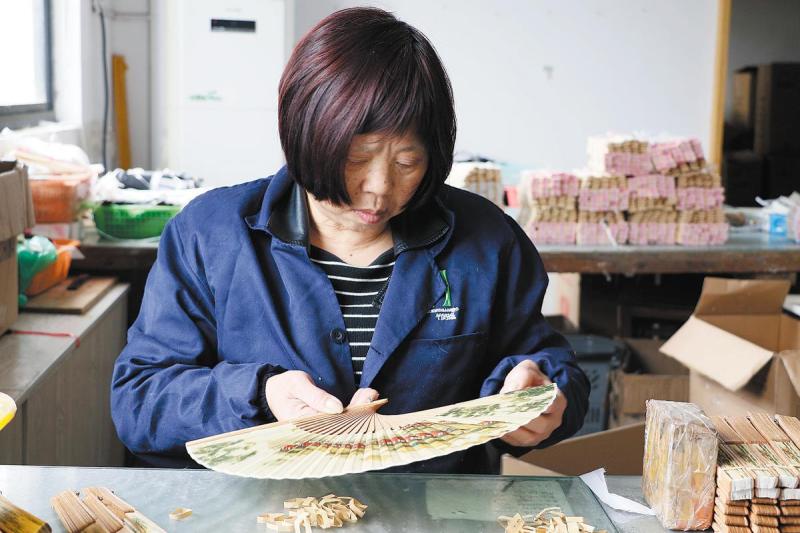




Plastic pollutes, bamboo does not. We just bought some bamboo chopsticks as a step towards a better environmental personal footprint.
Bamboo is one of the best renewable resources around with a multitude of uses! It's very hard to stop! Here in Boca Raton there's a lovely Japanese Garden Museum where the bamboo is huge and makes music when the wind blows.
The use of bamboo is food for thought, and pandas like it too.
I love this. Bamboo is amazing, grows super fast, and pound for pound, one of the strongest things in the world.
Bamboo is the best material for cutting boards.
In addition to Bamboo being recyclible,there's been some info lately that plastic cutting boards release microplastics.
I have one!
We have two, large and smaller.
And it's pretty good for a lot of other things too. In fact, if the little pig's house had been built of bamboo instead of some other kind of wood, the big bad wolf might not have been able to blow it down.
Well, as anyone who’s been on social media for any length of time knows . . . Some pigs are smarter than others!
Especially if its name is Napoleon.
Yep, bamboo is very versatile and is used in many different applications already. I've had bamboo sheets for about 15 years now, they are more durable than cotton and are softer and more comfortable also.
I've had bamboo sheets-- when I first got them I was surprised at how soft they were (especially since bamboo wood itself is so hard).
But are they more costly?
Like any other fabric, the price varies depending on the quality, etc. Prices for sets from bamboo can be found comparably priced but they last much longer I've found. I've got a set I've been using for on to ten years now and they are not threadbare, but holding up nicely.
Bamboo may be more plentiful in China but that doesn't mean that other nations can't plant bamboo forests in order to easily gain the benefits of it. After all,
Maybe they're even edible.
Usually, higher quality is more costly.
Makes no sense to NOT choose them.
But I'm not a Panda-- I'm not going to eat Bamboo sheets!
That depends on how hungry you are.
Or perhaps how tasty those particular sheets are?
Maybe they come in different flavours.
Hemp.
Hemp was grown in the U.S. during the colonial period. Prominent figures who grew Hemp included George Washington, Thomas Jefferson, Benjamin Franklin . . .
In the United States, cannabis was initially grown for industrial reasons, though it quickly became a staple medicinal product in the early 19th century.
....and then...?
There hav been some changes in laws. But in some ways its confusing-- or perhaps I should say a bit difficult to figure.
Due to our crazy system-- in terms of laws re: drugs (as well as other things) there federal laws-- but many states have their own laws.
(For example. IIRC, in some states the legal drinking age (for alcoholic beverages) is 18-- in others its 21!
In fact I know of cases where the legal age for drinkingis different in adjacent counties. (In many cases kids who couldn't buy alcohol in their county drove across the border to a county where they were of legal age!)
My father was in the burlap bag business, and I became quire familiar with hemp, but unless it is able to be refined to the softness that bamboo can be, you wouldn't want to sleep with hemp sheets. Better to smoke it.
IIRC, Hemp was also used to make very strong rope. (?)
I had a Bamboo plant in a vase in my Living Room. It was originally a single stalk, about maybe 8 or 10 inches high. It grew to several feet so -quickly!
Then what did you do with it? You could have donated it to a zoo that has pandas. I'm sure you didn't make paper out of it.